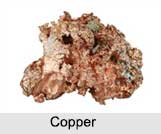 Copper Ore in India is only about 0.2 percent of world production. Copper is considered as one of the most important metal used in the country next to iron. Copper is used broadly in the manufacture of electrical machinery, cables and wires as it is a good conductor of electricity. This metal is also used for making brass and other similar alloys, coins and utensils. Defence as well automobile industries too use a huge quantity of copper and its alloys. However, it is the electrical industry that consumes an appreciable bulk of the total amount of copper produced in the world.
Copper Ore in India is only about 0.2 percent of world production. Copper is considered as one of the most important metal used in the country next to iron. Copper is used broadly in the manufacture of electrical machinery, cables and wires as it is a good conductor of electricity. This metal is also used for making brass and other similar alloys, coins and utensils. Defence as well automobile industries too use a huge quantity of copper and its alloys. However, it is the electrical industry that consumes an appreciable bulk of the total amount of copper produced in the world.
Copper Production in India
Mining of copper in India traditionally is more than 2000 years old. Its production to meet manufacturing demand is noted from the middle of 1960"s. With the opening of new mines, the production of copper ore has increased tremendously in the recent times. Of the total production of copper ore in India, Karnataka, Rajasthan, Bihar and Madhya Pradesh account for a major output. Now there are three more manufacturers in copper field such as Hindalco Industries Ltd, Sterlite Industries Ltd and Jagadia Copper Ltd.
Copper Mines in India
In India, copper ore belts are found in several regions. The major copper mines are the Khetri copper belt in Rajasthan, Singhbhum copper belt in Jharkhand and Malanjkhand copper belt in Madhya Pradesh. Rakha and Mosabani areas are the major mining areas. Further, in the Himalayan mountain ranges, rich deposits of copper ore are found. It is basically found near Rangpo in Sikkim and in Garhwal of Uttar Pradesh. However, even if the deposits of copper ore are found in some areas in huge quantity, they are not exploited in some areas because of poor transportation means and non-availability of electricity.
Promising deposit of copper ore occurs near Khetri town located near the Aravalli Mountain Ranges. It is a huge copper ore belt in the country with a heavy reserve. Other copper ore belts are found at Agnigundala in Guntur district, at Dariba in Alwar District, at Chitradurga, Kalyadi and Thinthini in Karnataka and at Dikchu in Sikkim. Few more areas in India where copper ore are found include Sirohi in Rajasthan, Chandrapur district in Maharashtra, Chitorgarh district and also in Phek district of Nagaland.



















